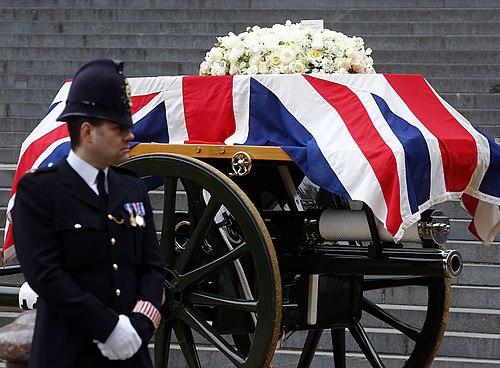On 17 April 2013, Britain paid its final respects to Margaret Thatcher, Baroness Thatcher, with a ceremonial funeral that underscored her towering legacy as the nation’s first female prime minister. Following her death on 8 April at the age of 87, the carefully planned service and procession through Central London offered a moment of solemn reflection for a figure whose influence continues to shape British politics.
The funeral, meticulously organised since 2009, began with Thatcher’s coffin, draped in the Union Flag, resting overnight in the Chapel of St Mary Undercroft at the Palace of Westminster. A motor hearse carried the coffin through Whitehall, Trafalgar Square, and the Strand, before a blessing at St Clement Danes, the RAF’s central church. The coffin was then transferred to a gun carriage drawn by the King’s Troop, Royal Horse Artillery, continuing along Fleet Street and Ludgate Hill to St Paul’s Cathedral. At the Tower of London, a 105 mm gun fired every 60 seconds during the procession, and flags along Whitehall flew at half-mast.
At St Paul’s, the service was attended by Queen Elizabeth II—a rare presence, marking only the second time she had attended a prime minister’s funeral, after Winston Churchill’s in 1965. The Dean of St Paul’s, David Ison, opened the service, with readings delivered by Thatcher’s granddaughter Amanda and then-Prime Minister David Cameron. The Bishop of London, Richard Chartres, gave a poignant address. Hymns chosen by Thatcher, including Charles Wesley’s “Love Divine, All Loves Excelling,” reflected her Methodist roots. The guest list was extensive, including representatives from some 200 countries, former British Cabinet members, and all four living British prime ministers at the time.
The funeral, with its military honours and guard of honour, mirrored arrangements for the Queen Mother in 2002 and Diana, Princess of Wales, in 1997. Supporters hailed the scale of the ceremony as fitting for a leader of Thatcher’s stature, though some, including the Bishop of Grantham, Tim Ellis, and politicians Lord Prescott and George Galloway, questioned its grandeur. Despite fears of IRA protests, the procession was marked by respectful crowds, with supporters’ cheers largely drowning out scattered dissent.
After the service, Thatcher’s coffin was taken to Mortlake Crematorium for a private cremation attended only by immediate family. On 28 September 2013, her ashes were interred alongside those of her husband, Denis, at the Royal Hospital Chelsea in a private ceremony, concluding a chapter in Britain’s history.
Thatcher’s funeral was more than a farewell; it was a moment for the nation to reflect on a transformative era. Her legacy remains a cornerstone of modern British identity.






Leave A Comment